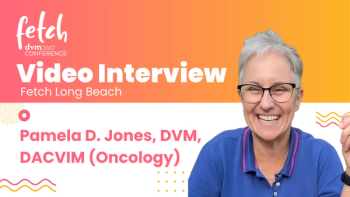
- dvm360 September 2022
- Volume 53
- Issue 9
- Pages: 71
A veterinary rehabilitation specialist shares his approach to osteoarthritis management and more
On dvm360® Live!™, Matt Brunke, DVM, DACVSMR, CCRP, CVPP, CVA explains how a new product has changed his approach to osteoarthritis treatment
This content sponsored by Synovetin OA / Exubrion
Many aspects of veterinary medicine factor into rehabilitation and sports medicine: pain management, medication, acupuncture, and physical therapy, to name a few. For one veterinary rehabilitation specialist, it all comes down to mobility. The latest episode of dvm360®Live!™ featured Matt Brunke, DVM, DACVSMR, CCRP, CVPP, CVA, who shared his
Why veterinary rehabilitation and sports medicine?
Brunke has a personal rule: Walk your dog for an hour a day. That may have been the catalyst that set him down the road of rehabilitation and sports medicine, he said. For Brunke, mobility directly relates to quality of life for the patient and the pet owner. Helping animals be more active by managing chronic pain and treating mobility issues allows everyone to get that 1 hour a day that can mean so much to both the pet and the human-animal bond.
“The first part is just that it’s quality of life; we want to spend more time with our pets,” Brunke said. “I’ve accrued a bunch of letters after my name in the pursuit of fixing mobility…and for me, mobility is life…because you want to have an active life with your dog or other pets, right?”
Brunke added that learning how to manage and improve chronic issues has been a focal point for his career. “It became a quest of understanding how to fix things….We don’t always have cures, but the best we can do to [help patients] improve is key,” he said.
Rehabilitation for military working dogs
Part of Brunke’s rehabilitation journey involved serving military working dogs and police dogs. He worked in the Albany area of New York for over a decade, where he had the opportunity to treat New York State Police canines. He recalled a story in which they brought him a dog with an anterior cruciate ligament injury. The policy at the time, he said, was to treat the dog but retire it from service on the spot.
That’s when Brunke made a bold statement: “This is a 3-year-old dog [who] they had already invested over 6 figures of training into, so I was a little brash and said, ‘No, we can fix this. We can put this dog back to duty in 3 months.’ And my boss [said], ‘You just said that in front of the head of all the New York state troopers, so you better be right.’” That dog was back to work in under 3 months and served another 9 years after treatment by Brunke’s team. From there, Brunke went on to Washington, DC, to help treat active and retired military working dogs with both the Central Intelligence Agency and the United States Secret Service.
A new modality for multimodal osteoarthritis management
Brunke described osteoarthritis management as a passion project, which he feels may be underappreciated at times. He said many clients, and even veterinarians, may resign themselves to the idea that pets naturally lose mobility as they get older. “We just think ‘Well, they got old, so they shouldn’t move around as well,’” Brunke said. “That shouldn’t be a standard [of care] for us….Age is not the disease.”
Following up that statement, Brunke shared a new modality his team has added to its toolbox: targeted injectable therapy. He asked rhetorically: Why treat a single joint or site with systemic drugs that may have the potential for adverse effects? Brunke then walked Christman through how he uses a product called Synovetin OA® (Exubrion Therapeutics®) in his clinic to treat dogs with elbow osteoarthritis. “Synovetin OA is a new treatment that is injected into that joint—it doesn’t get out into the rest of their body—and it starts to decrease all those white blood cells and angry inflammatory things that are eating away the cartilage 24/7…for 365 days,” he said.
Brunke also added that “Synovetin OA attacks the synovitis. That’s what makes all the fluid [and causes] all the pain.” He said that taking this targeted approach may improve the patient’s symptoms to the point where systemic drugs are no longer needed. As of June 2022, his clinic has treated 80 patients and 137 joints with this treatment and is seeing 20- to 30-degree improvements in range of motion within a month, and pain relief lasting for up to a year.1
Reference
- Oliver K. Introduction to rehabilitation: the what and how-tos of physical rehabilitation. Presented at: Directions in Veterinary Medicine; June 24-25, 2022; Indianapolis, IN.
Articles in this issue
about 3 years ago
We DO talk about Bruno (and Clifford and Wininger)about 3 years ago
Dream team creates their ideal veterinary clinicabout 3 years ago
The Dilemma: Whom should I hire?about 3 years ago
5 questions to answer if you’re considering practice managementabout 3 years ago
What to know before taking out a loan to purchase a practiceabout 3 years ago
Understanding laparoscopy in veterinary surgeryabout 3 years ago
Team building is crucial to a successful practiceover 3 years ago
Managing acral lick dermatitis in caninesNewsletter
From exam room tips to practice management insights, get trusted veterinary news delivered straight to your inbox—subscribe to dvm360.




